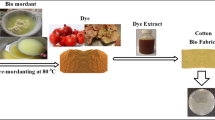Abstract
We have described a novel red biochrome, 514 Da in size, produced by solid-state cultivation of a bacterial isolate obtained from garden soil. The growth requirements of the isolate, the chemical characteristics of the biochrome produced, and the application of the biochrome in dying of silk, wool, and cotton fabrics have been studied. The biochrome obtained after 52 h of incubation and having a λ max of 535 nm was used for dyeing the fabrics. We found that silk, wool, and cotton fabrics dyed with this new natural red compound have high color strength values and dye uptake along with good color fastness as well as antibacterial activity.










Similar content being viewed by others
References
Hill, D. J. B. (1997). Is there a future for natural dyes? Review Progress in Coloration, 27, 18–25.
Bhattacharya, S. D., & Mathew, S. (2002). Wool dyeing by natural colourants. Colourage, 49, 19–24.
Williams, R. P., Green, J., & Rapp port, D. A. (1956). Studies on pigmentation of Serratia marcescens. I. Spectral and paper chromatographic properties of prodigiosin. Journal of Bacteriology, 71, 115–120.
Britton, G. (1983). The biochemistry of natural pigments. Cambridge: University Press.
Dufosse, L. (2009). Pigments, microbial. Encyclopedia Microbiology, 4, 457–471.
Pathak, H., & Madamwar, D. (2010). Biosynthesis of indigo dye by a newly isolated naphthalene-degrading strain Pseudomonas sp HOB1 and its application in dyeing cotton fabric. Applied Biochemistry and Biotechnology, 42, 207–219. doi:10.1007/s12010-009-8638-4.
Alihosseini, F., Ju, K., Lango, J., Hammock, B. D., & Sun, G. (2008). Antibacterial colorants: characterization of prodiginines and their applications on textile materials. Biotechnology Progress, 24(3), 742–747. doi:10.1021/bp070481r.
Grimont, P. A. D., & Grimont, F. (1978). The genus Serratia. Annual Review of Microbiology, 32, 221–248.
Ajithkumar, B., Ajithkumar, V. P., Iriye, R., Doi, Y., & Sakai, T. (2003). Spore-forming Serratia marcescens subsp. sakuensis subsp. nov., isolated from a domestic wastewater treatment tank. International Journal of Systematic and Evolutionary Microbiology, 53, 253–258. doi:10.1099/ijs.0.02158-0.
Bennett, J. W., & Bentley, R. (2000). Seeing red: the story of prodigiosin. Advances in Applied Microbiology, 47, 1–32.
Venil, C. K., & Lakshmanaperumalsamy, P. (2009). An insightful overview on microbial pigment, prodigiosin. Electronic Journal of Biology, 5(3), 49–61.
Todd-Guay, M. & Demchick, P.H. (1995). Role of prodigiosin in phosphate-starved Serratia marcescens. Abstract of the Annual Meeting, American Society for Microbiology.
Giri, A. V., Anandkumar, N., Muthukumaran, G., & Pennathur, G. (2004). A novel medium for the enhanced cell growth and production of progidiosin from Serratia marcesences isolated from soil. BMC Microbiology, 4, 11.
Bu’lock, J. D. (1967). Essays in biosynthesis and microbial developments. New York: Wiley.
Khanafari, A., Assadi, M. M., & Fakhr, F. A. (2006). Review of prodigiosin, pigmentation in Serratia marcescens. Online Journal of Biological Sciences, 6(1), 1–13.
Quadri, S. M. H., & Willams, R. P. (1973). Role of methionine in biosynthesis of prodigiosin by Serratia marcescens. Journal of Bacteriology, 116(3), 1191–1198.
Scott, R. H., Quadri, S. M. H., & Willams, R. P. (1973). Role of l-proline in the biosynthesis of prodigiosin. Applied and Environmental Microbiology, 32(4), 561–566.
Acknowledgments
The authors wish to express a deep sense of gratitude to the Department of Biotechnology, Ministry of Science, Government of India, for the financial support extended for this project. The authors also wish to thank Dr. Narendra Raut, Piramal Life Sciences Ltd., Mumbai, for MS and NMR analysis. The authors also duly thank Dr. Vijay Gangan, Reliance Life Sciences Pvt. Ltd., Mumbai, for his valuable assistance in characterization studies.
Author information
Authors and Affiliations
Corresponding author
Rights and permissions
About this article
Cite this article
Vaidyanathan, J., Bhathena-Langdana, Z., Adivarekar, R.V. et al. Production, Partial Characterization, and Use of a Red Biochrome Produced by Serratia sakuensis subsp. nov Strain KRED for Dyeing Natural Fibers. Appl Biochem Biotechnol 166, 321–335 (2012). https://doi.org/10.1007/s12010-011-9427-4
Received:
Accepted:
Published:
Issue Date:
DOI: https://doi.org/10.1007/s12010-011-9427-4




